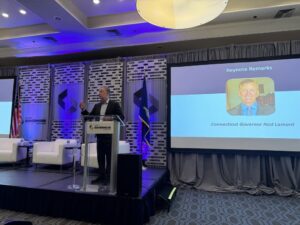With Governors focused on aligning workforce and economic development activities across states, NGA’s biannual Workforce Development Policy Institute brought together state leaders, including Connecticut Governor Ned Lamont, to discuss how states are developing a skilled workforce and expanding economic opportunities for residents.
The NGA Center for Best Practices (NGA Center) hosted its Biannual Workforce Development Policy Institute in Mystic, Connecticut, October 30 – November 1.
The Institute brought together Governors’ workforce development policy advisors, Governor-appointed leaders of state workforce agencies, and chairs of Governors’ workforce development boards from more than 30 states and territories. These leaders carry out their Governor’s vision for workforce development policy, strategic investment, and the administration and oversight of federal and state workforce programs. Institute programming offered participants opportunities to share challenges and best practices with one another and engage in solutions-oriented dialogue with subject matter experts, business and nonprofit partners, and policymakers across all levels of government.

Connecticut Governor Ned Lamont welcomed attendees to the Institute and delivered keynote remarks regarding his top workforce development policy priorities as well as the impact of artificial intelligence (AI) on workforce development policymaking. Governor Lamont also discussed the close partnership Connecticut has fostered with employers and Connecticut’s efforts to retain talent.
Following Governor Lamont’s keynote remarks, Rob Vatter, the Executive Vice President of Enterprise Platform Services at Cognizant, joined Kelli-Marie Vallieres, Governor Lamont’s Chief Workforce Officer, for a fireside chat to dive deeper into upskilling workers to adapt to the impact of AI. They discussed opportunities for Governors to partner with employers to ensure the needs of workers and businesses are reflected in training and education opportunities that will increase the economic competitiveness of the United States’ workforce.
Participants also toured General Dynamics Electric Boat, which has been building submarines for the United States military since 1899. Attendees heard first-hand how Connecticut’s Manufacturing Pipeline Initiative is helping to connect workers to good-paying jobs, increase career awareness as early as elementary school and support Electric Boat in developing a sustainable talent pool.
Other topics discussed during the Institute included:
- implementing digital upskilling,
- technology for better workforce service delivery,
- disability inclusive workforce policy,
- housing policies that support efforts to grow the workforce,
- entrepreneurship as a tool for workforce development,
- supporting workforce integration for skilled immigrants,
- the role of state workforce development boards in advancing apprenticeship and
- national economic trends and the resultant impact on workforce development.
During the Institute, the NGA Center highlighted a new request for applications for a Service-to-Career Pathways Policy Academy, which will support states and territories in developing service-to- career pathways as a pathway of economic opportunity in key sectors for young people. The NGA Center also shared a new paper developed in partnership with the Project on Workforce at Harvard on Governors’ solutions to leverage new industrial policy to strengthen workforce development in their states. NGA also shared a new brief on Governors’ leadership to expand youth apprenticeship through the NGA Center’s Policy Academy to Advance Youth Apprenticeship as well as a new disability inclusive workforce policy effort, which will identify high-impact opportunities for Governors to increase state employment opportunities for people with disabilities.
The Institute featured several panel discussions and remarks from experts from across the country. Featured speakers included:
- Rosalin Acosta, Managing Director, Government & Public Sector, Ernst & Young LLP
- Angelo Farooq, Chair, National Association of State Workforce Board Chairs; Chair, California Workforce Development Board; Owner, AVM Innovation Consulting, LLC
- Cami Feek, Commissioner, Washington Employment Security Department
- Thomas Foley, Deputy Secretary of Policy and Planning, Office of Pennsylvania Governor Josh Shapiro
- Mark Gaspers, Director of Government Operations, Boeing; Chair, Workforce Arizona Council
- Charlie Gill, Account Director, LinkedIn
- Alicia Halle, Assistant Director, Vocational Rehabilitation, North Dakota Health and Human Services
- Poppy Hernandez, Executive Director, Office of Global Michigan
- Kimberly Hill Ridley, Chief Disability Officer, New York
- Paige Kuntz, Global Talent Coordinator, North Dakota Office of Legal Immigration
- Wendy Lader, Northeast Regional Director, Office of Internet Connectivity and Growth, National Telecommunications and Information Administration, U.S. Department of Commerce
- Katie McClelland, Director, Minnesota Governor’s Workforce Development Board
- Katie Milligan, Program Director for Entrepreneurship, Human Capital and Workforce Development, Heartland Forward
- Seila Mosquera-Bruno, Commissioner, Connecticut Department of Housing
- Ryan Oakes, Global Health & Public Service Industry Practices Chair, Accenture
- Joshua Richardson, Chief of Staff, Indiana Department of Workforce Development
- Lauren Schoenfeld, Senior Policy Advisor and Wyoming Innovation Partnership Director, Office of Wyoming Governor Mark Gordon
- Kit Taintor, Senior Director of US Policy and Programs, World Education Services
- Deniece Thomas, Commissioner, Tennessee Department of Labor and Workforce Development
- Meghan Wadsworth, Assistant Policy Director, Economic Development, Office of Ohio Governor Mike DeWine
- Dr. Robert Wescott, President and Founder, Keybridge
- Taryn Williams, Assistant Secretary for Disability Employment Policy, U.S. Department of Labor
NGA’s Workforce Development and Economic Policy page provides more information about the work NGA and states are doing to align workforce and economic development activities across their states.












